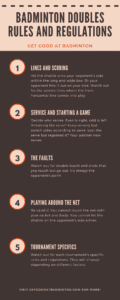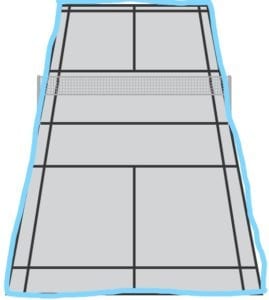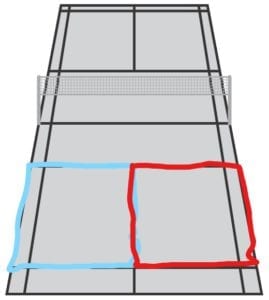Recently, I did a post on badminton rules and regulations for singles and thought that it might be helpful also to do a badminton rules and regulations for doubles post. You’ll find that most of the rules are the same as singles with minor differences and they apply to all types of doubles play; men’s and women’s doubles as well as mixed doubles.
Let’s get into lines and scoring first.

Lines and Scoring
As the name suggests, doubles is a variation of badminton played with two people instead of one. Thus, the lines will change a little.
Because of the two people, doubles play makes use of the entire court. Meaning that shots within the outermost lines are in.
The same thing as singles, if you’re a professional player, the highest level tournaments will often allow you to challenge the calls by the line judges. Of course, most of us are not at that level and don’t have to worry.
Another difference of doubles with singles is the lines used for serving. Unlike singles where the horizontal back line is used at all time, the front horizontal line is used when players serve. Basically, you can’t serve as far as you usually can in singles.

Scoring in doubles is the same as scoring in singles. You get points by either landing the shuttle in on your opponent’s side, or your opponent hits it out on your side. Games once again go up to 21 and matches are usually of best of three.
In each game, players must also win by two or until one player reaches 30 points. Basically, the score can go from 22-20, 23-21, 24-22, 25-23, all the way until 30-29 when the game ends.
At 11 points or in between games, coaches will usually get an opportunity to talk to you just like in singles.
Service and Starting A Game
To start a game of badminton, you must first decide which pair is serving. It’s done in the same way as singles either officially through a coin flip or casually by throwing up the shuttle and seeing which way it points to.
Before the game, both sides should get an opportunity to practice serve in which all players on the court will take turns serving once. Sometimes it will depend on your tournament rules as well.
Whoever is serving will start on the right side because the score is even. If it’s odd, one of the players will serve on the left side. Players also need to stand behind the service line and serve the shuttle past the opponent’s service line. If they don’t, it is called short and your opponent’s point.
During the match is when it gets more confusing. If you serve and you retain the serve by getting points consecutively, you will continue serving and switch sides depending on the score. If you lose the serve and then regain the serve, whoever was serving before will, and the other player will serve. This means, if you were serving before, your partner would now serve, and if your partner were serving previously, you would now serve.
I hope that makes sense. If you have any questions, please ask in the comment section down below!

Another rule with doubles is that when you serve, you must stand on one side and behind the service line. However, your partner does not have to and can stand anywhere on the court. Generally, although not the rule, in women’s and men’s doubles, your partner stands behind you, and in mixed doubles, the guy usually always stands behind the girl.
If you’re playing a match, the winner of the previous game will get to serve next.
The service height rules are also the same as singles where you officially have to serve below 1.15 meters. But usually serving below the waist should suffice. Make sure you check the tournament rules.
Checking service height is a lot more common in doubles as players like to play a variety of serves such as a punch serve and flick serve and some players will often hit it too high above their waist.
Double Touch, Carries, and Other Faults
There are plenty of shots that can be considered as faults. Some of the most notable ones are hitting the shuttle twice in a row, scooping it up from the ground, and touching the shuttle if it goes out. If any of this happens to you, it will automatically be the opponent’s point and vice versa.
Another common thing to check is when a pair’s rackets clash. Generally, this is okay, but in some tournaments, they rule it as double touch. Make sure you check the tournament rules out. You should be okay though because racket clashing is relatively uncommon with excellent synergy.
I didn’t note this in the rules and regulations of the single because it basically never happens, but in doubles, especially professional doubles where the rallies are incredibly intense, if you drop the racket and play the shuttle with your hand, it does not count. Again, sporadic case but I did see it happen once.
Something that I found from badminton beginners is that they think you’re not allowed to switch rackets while in a rally. While this is uncommon, in doubles, it is feasible and more frequent when players break their racket strings, and there is no regulation regarding this.
Similar to the situation above, there also isn’t a rule regarding how much a player has to hit the shuttle. As long as the pair follows the service rules, technically only one person has to hit the shuttle. There is no “everybody needs to play” rule.
Playing Around The Net
Many faults occur at the net. Players may often play too aggressively and either hit on the opponent’s side or hit the net itself. Like singles, here are some net play rules.
- You cannot hit the shuttle while it’s on your opponent’s side.
- Your foot cannot be on the other person’s side when hitting the shuttle.
- You cannot hit the net with your racket or other parts of your body when playing the shot at the net.
Although I see situations where a player net kills, and the other player’s racket is up and blocks the net kill less in doubles than in singles, it is still a situation that receives a lot of controversy due to the speed of the game.
Most lower level tournaments don’t have an umpire watching the net from a higher viewpoint which makes it even more difficult to judge whether or not a player has violated the rules. The only thing I can say here is to do your best and try to come to an agreement with the other player.
One thing to note is that you cannot hit the net with your racket or other parts of your body but the shuttle can hit the net, and it will be your point if it lands on your opponent’s side. Just a reminder for when someone calls you out on the shuttle hitting the net.
Tournament Specifics
Although what I said are standard across BWF terms and most tournaments, each individual competition will have different rules and regulations that you have to follow.
Some variations include scoring and how much your coach is allowed to talk to you. I know that school badminton often change up the scoring rules because of the number of players, time, and limited court space. During junior high/middle school, I found that all of the games were being played to 15 with no deuces and everything was best of one. Coaches were also not allowed to talk to us until after the game too.
Other times, tournaments would have regulations regarding sizing of logos on your shirt or even the color of the shirt you’re wearing. Many higher level tournaments also require that your shirt has your name and country on it as well.
For doubles specifically, most higher level tournaments require that the players wear matching clothes. Meaning that the shirt and the shorts are often the same. Same thing for mixed doubles although girls are allowed to wear skorts while the boy wears shorts. They just have to be the same color.
It all depends on the tournament specifics. It’s why you should play more badminton tournaments. Because when you come to different settings and new rules, you won’t be bothered or surprised too much and thus your play won’t deteriorate.
Conclusion
Comment down below if you thought I missed anything or if you have something to add! You should be able to get a game of doubles set up now after seeing this post. If you’re a badminton singles player, make sure you check out my post about badminton rules and regulations for singles too!
As always, good luck in your games and have a great day!


Are you sure these rules are right and updated?
For now, yes. If you want, you can check the official BWF handbook as well. My post is more of a general how to play badminton kind of thing.
Just played MD in fund raising tournament. A player on the opposite team claim that we double hit. While I claimed that I swung the racket and missed the shuttle, he stated that “new rules” states that if the swing alter the trajectory of the shuttle, it is a double hit. I didn’t argue and gave him the point.
My question is that is there such a rule change/update?
No, I have not seen that rule in the BWF handbook. However, if you’re playing a fund-raising tournament (which is likely not an official BWF regulated tournament), there may be such rules in place. Although this “new rule” about the double hit seems extremely unlikely to be an actual rule because of how difficult it is to one, change the trajectory of the shuttle during play without touching the shuttle, and two, how difficult it is to actually judge the shuttle’s trajectory change. Personally, I would just deny that I touched or even changed the trajectory of the shuttle and keep the point. Hope that helps 🙂
K, so now i know why my whole arm started hurting after my first day of playing badminton. I was holding it the wrong way.
Awesome! Hopefully, no more injuries.
Great! I didn’t know such interesting facts about badminton doubles, though I have playing for around a year now. Thanks for valuable content.
No problem. Also, make sure to check out some of my posts on how to improve your doubles gameplay!